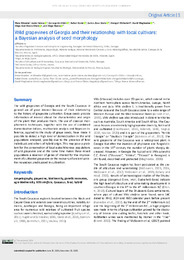Please use this identifier to cite or link to this item:
https://hdl.handle.net/11000/38300Full metadata record
| DC Field | Value | Language |
|---|---|---|
| dc.contributor.author | Kikvadze, Maia | - |
| dc.contributor.author | Valera, Javier | - |
| dc.contributor.author | Obón, Concepción | - |
| dc.contributor.author | Ocete, Rafael | - |
| dc.contributor.author | Álvar Ocete, Carlos | - |
| dc.contributor.author | Kikilashvili, Shengeli | - |
| dc.contributor.author | Maghradze, David | - |
| dc.contributor.author | Rivera Obón, Diego José | - |
| dc.contributor.author | Rivera, Diego | - |
| dc.contributor.other | Departamentos de la UMH::Biología Aplicada | es_ES |
| dc.date.accessioned | 2025-11-19T12:44:00Z | - |
| dc.date.available | 2025-11-19T12:44:00Z | - |
| dc.date.created | 2024 | - |
| dc.identifier.citation | VITIS: Vol. 63, Art. 9, 19 pp. (2024) | es_ES |
| dc.identifier.issn | 2367-4156 | - |
| dc.identifier.uri | https://hdl.handle.net/11000/38300 | - |
| dc.description.abstract | The wild grapevines of Georgia and the South Caucasus in general are of great interest because of their relationship to the history of grapevine cultivation. Grape seeds provide information of interest about the characteristics and origin of the plant that produces them. The use of classical morphometric techniques, together with the use of combined domestication indices, multivariate analysis and Bayesian inference, applied to the study of grape seeds, have made it possible to detect a high level of domestication in the wild populations analyzed, possibly due to the presence of feral individuals and others of hybrid origin. This may pose a problem for the conservation of local autochthonous populations of wild grapevine and at the same time makes these mixed populations a reservoir of genes of interest for the improvement of cultivated grapevine or the recovery of ancient varieties nowadays predisposed in cultivation. | es_ES |
| dc.format | application/pdf | es_ES |
| dc.format.extent | 19 | es_ES |
| dc.language.iso | eng | es_ES |
| dc.rights | info:eu-repo/semantics/openAccess | es_ES |
| dc.rights.uri | http://creativecommons.org/licenses/by-nc-nd/4.0/ | * |
| dc.subject | Ampelography | es_ES |
| dc.subject | grapevine | es_ES |
| dc.subject | biodiversity | es_ES |
| dc.subject | genetic resources | es_ES |
| dc.subject | agrobiodiversity | es_ES |
| dc.subject | Vitis vinifera | es_ES |
| dc.subject | Caucasus | es_ES |
| dc.subject | feral | es_ES |
| dc.subject | hybrid | es_ES |
| dc.title | Wild grapevines of Georgia and their relationship with local cultivars: a Bayesian analysis of seed morphology | es_ES |
| dc.type | info:eu-repo/semantics/article | es_ES |
| dc.relation.publisherversion | https://doi.org/10.5073/vitis.2024.63.09 | es_ES |

View/Open:
17156_r vitis_2024-01_kikvadze_et_al.pdf
1,47 MB
Adobe PDF
Share:
.png)
